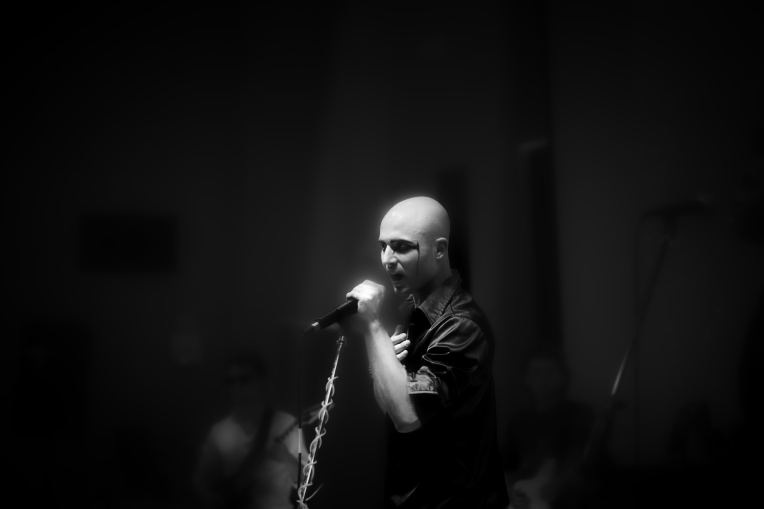Music and life start the same way: as a seed germinating until it is ready for the world. Many have beaten objects for want of rhythm; others have extended their bodies through instrumental prostheses in deference to melody. But the most primal search of the modern age is that of a voice for an amplifier. Ithaca, New York-based singer Kurt Riley is one such seeker, holding a microphone like a newborn whose umbilical cord twirls back into the electric womb where his second album Kismet has been incubating for over a year.
A student among a band of students, Kurt has balanced his academic life at Cornell University with a musical one on another planet, from which his sonic gatherings at last fell into place during his premiere performance on April 29, 2016.
Teaming up with the glam rocker on this interstellar ride were drummer Olivia Dawd, bassist Charlie Fraioli, guitarists David Dillon and Sam Packer, keyboardist Ruth Xing, saxophonist John Mason, and backing vocalist Kristina Camille Sims. The latter added dialectical undercurrents to Riley’s over, balancing dichotomies not only of gender but also temporality and location in the grander context of his outreach.
The band played the entire album from front to back, opening with the instrumental “Eternity,” a synth-heavy blush that plowed through stardust in a procession of songs without words. Wavering before a backdrop of endless galaxy, Kurt and his musicians prepared their earthly transmission with steady hands and fibrillating hearts. Not only was it a portal of insight into the emotional story about to unfold, but also a foreshadowing of hope: a touch of rain amid the brimstone to ease the pain of progress. More importantly, it lent sanctity to the venue, allowing us to forget we were sitting in nothing more than a university auditorium. Between the retro arpeggio, which flushed the audience of its insecurities in a space normally reserved for less intimate instruction, and the slack guitar floating above it all, a cosmos waited to unleash its primal scream.
In their rendition of “Eye of Ra,” the album’s first proper song (at least on human terms), Kurt and his astronauts stared into the face of something sinister and acknowledged lack of escape from that which knows us without sight. Hanging on to a kingdom by its lowest rungs, a realm where hardship is a prerequisite for the course of life, they nevertheless cradled this dire circumstance for what it was: a baseline of realism that allows lowly citizens to remember, in the end, just how far they’ve come beneath untouchable authority.
Like motivations flowed through the follow-up song, “Engines Are Go!” Here the narrative voice was youthful, almost naïve in its gradation from verse to chorus. Kurt pushed these images through the mesh of experience until they were unrecognizable as their former selves. This road trip through the unrequited jungle gave over to “Theft of Fire.” The first incision of an even more romantic surgery, it was a turning of tidal expectations from doom to failure, the key difference being that the latter involves a choice.
The first single off Kismet, “Hush Hush Hush,” provided the most classic sound. Its pianistic backbone flexed to the beat of a retroactive metropolis in anticipation of biting its own tail. As the ballade du jour, it was a singular passage of reflection, projected through a darkly loving lens of yearning. All of which fed into the first push of “Domino,” sending us all through a cavity of falling rocks.
The circularity of “As We Know It” came about through words of material destruction. “Humanity: Why so in love with the end of things?” Kurt sang, blowing his brains out through a harmonica at the end like a catharsis beyond false semantic promises. It was also a turning point in the program, which paled from black to red as the contours of “Whore” came into focus. For this, Kurt was joined by local rapper Asanté Quintana, whose delivery rose like gorge mist through safety netting.
This sea change was further evident in “God’s Back in Action,” a piece of soul for the lonely sharpened to an edge of comfort. It was the very definition of the Kurt Riley experience, which behind the weathered leather and mascara teardrops cradled a motivation of care. As too in the all-reaching “Universe” especially, a Queen-like danse macabre for the soul, true love was never far behind.
And in “Human Race,” which sent balloons flying throughout the auditorium, Kurt pulled that hope into the present. A self-imagining broken into heated breath…

…but nowhere more so than in “Burn It Up,” which gave that hope a vessel in which to soar.

And with that benediction, closed like a fist around slippery assurances, Kurt and his mortal cohort closed up the castle, swept the blood and sweat under the carpet, and tread out into the galactic night with new followers in tow.
Toward the end of his life, David Bowie once characterized himself as a man lost in time, but Kurt is one who is just beginning to find himself in it. Should you wish to know more about his time on Earth, which is sure to breed noteworthy developments, click the album cover below.
See you on the other side.
(Concert photos: Yours Truly)











